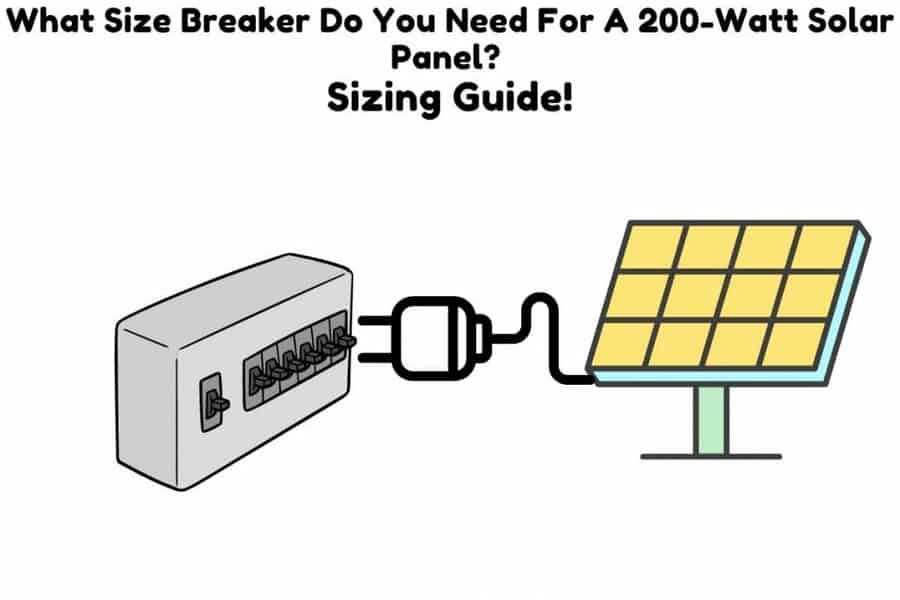Electricity costs for a motorhome can range anywhere between 60 to $100 per month depending on your location. Adding a few solar panels even just to handle smaller appliances can knock off a few dollars off the cost.
Five 200-watt solar panels can produce around 4.5 kWh of energy per day. That is almost a quarter of what the average motorhome uses in a day. Each 200-watt solar panel requires a 20-amp breaker or fuse.
But how much energy does a single 200-watt solar panel produce and how do you size solar panel breakers? Let’s explore these questions by using a motorhome or RV as a practical real-world example. What could you power in an RV using a 200-watt solar panel and what would you need?

How Many Amps Does A 200-Watt Solar Panel Put Out?
A 200-watt solar panel can produce between 30-to-70-amp hours per day. The exact amount is dependent on specifics like location and the solar panel type. The amperage will also vary depending on the voltage of the solar panel. The higher the voltage the fewer amps it produces.
On a side note! If you’re in need of a reliable and high-performance portable solar panel, We strongly recommend the Jackery SolarSaga 100W Portable Solar Panel (Amazon Link).
With a high conversion efficiency and foldable design, this solar panel is easy to transport and set up, making it perfect for outdoor activities like camping, hiking, and RV trips.

The US solar cell technology used in this panel ensures that you get the most efficient and reliable solar charging possible.
There is also a 60W option that is more affordable (Amazon Link)
How do you work out how much energy a 200-watt solar panel will provide? Primarily, you need to know how much sunlight your solar panel will receive. This is the main factor that will determine the output.
Peak sunlight hours (PSH)
Peak sun hours are the hours in which the intensity of sunlight or solar irradiance reaches an average of 1,000 watts of energy per square meter (roughly 10.5 feet). It is the hours when the sun is at its most intense.
Peak sun hours are what are used to rate a solar panel. If a solar panel is rated at 200 watts, this means it produces 200 watts at an irradiance of 1,000 watts.
Non-peak sun hours are when the sun is not at its brightest as in the early mornings and late afternoon. At those times irradiance can be as low as 500 watts per square meter.
Solar panels will produce less power at those times because there is less available sunlight to convert into energy. 2 hours of sunshine in the morning that receives 500 watts will give you 1 peak sun hour. The same goes for the late afternoon.
Peak sun hours increase the closer you get to the equator. In the U.S, states in the south have more peak sun hours than states up north. Fortunately, you don’t need to work out how many peak sun hours you will receive yourself. You can use a sun hours map or Google’s Sunroof Project. Source
The efficiency of solar panels
After, peak sun hours, solar panel efficiency is the second most important factor that will determine energy output. Solar panels are categorized by whether they are thin-film or silicon. Thin film solar panels are the least efficient.
Silicon solar panels are more efficient with monocrystalline being the most efficient of the two types of silicon panels. Source
| SOLAR PANEL TYPE | EFFICIENCY (%) |
| Monocrystalline | 18-22% |
| Polycrystalline | 15-18% |
| Thin-film | 12-14% |
Once you know the peak sun hours in your state, working out how much energy your solar panel will provide is simple mathematics. A 200-watt solar panel with a voltage of 18 volts produces around 11 amps.
To get how much energy the solar panel would produce in a day you multiply the amps by the number of peak sun hours. Using Arizona, which receives the most peak sun hours at 8 in the U.S, this is what that would look like:
11A x 8 hours = 88-amp hours.
How Many Amps Does A 12V 200-Watt Solar Panel Produce?
Under standard test conditions, a 12V 200-watt solar panel should produce 16.6 amps. Converting the watt power rating of a solar panel is done by dividing watts by the voltage. 200 (watts) / 12V (volts) = 16.6A. In real-world conditions, the output is closer to 10 amps.
200-watt solar panels can come in different voltages. You will also find them with voltages of 18V and 28V. The most common types tend to be 18V.
How Do You Size A Breaker For Solar Panels?
Breaker sizing for solar panels is determined by the power rating of the solar panels. If there is more than one solar panel then the solar array design or how the solar panels are wired together also has to be considered. A rule of thumb used to size breakers is that they should be 125% the size of the output of the solar panels.
Sizing a breaker for a single solar panel is simple. A breaker needs to be oversized by 25%. Using our 200-watt 18V solar panel which produces 11 amps, the formula would be as follows:
11 amps x 1.25 = 13.75 amps.
Here a 15-amp breaker would be adequate.
Sizing breakers for multiple solar panels depends on how the solar panels are wired together. Solar panels can be wired in series or parallel. Adding solar panels in series increases the voltage while keeping the amperage the same.
Five 200-watt solar panels of 18V will produce 90V and 11 amps. Using the formula above would therefore yield the same size breaker.
The math for a parallel string of solar panels will work out differently. Adding solar panels in parallel maintains the voltage but increases the amperage. A parallel string of five 200-watt solar panels would produce 18V and 55 amps. The formula for the breaker size would look like this:
55 amps x 1.25 = 68.75 amps
Here a 70-amp breaker would be used.
What Do I Need For A 200-Watt Solar System?
For AC appliances, an inverter is necessary. If running DC appliances there is no need for an inverter. If energy storage is required both a battery and charge controller is necessary.
What you need for a 200-watt solar system depends on what you intend to use the system for. A 200-watt system is a very small system capable of powering small appliances like laptops, mobile chargers, mini-fridges, and small TVs.
If you don’t need energy storage, in which case your system will only work during the day, then all you would need in addition to the solar panels would be an inverter. The inverter converts the direct current a solar panel produces into alternate current the appliances use.
If you want to run your appliances at night, using stored solar energy then a battery, as well as a charge controller, are necessary. In all cases, you will need to have breakers as well.

